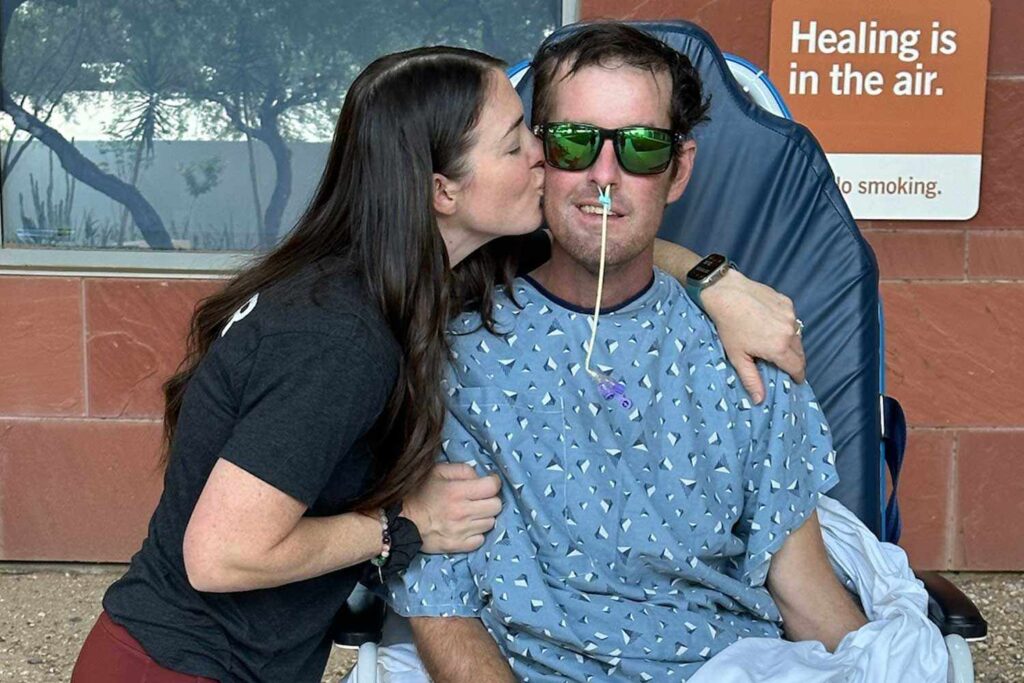NEED TO KNOW
As a competitive powerlifter and a hardworking telecommunications contractor, Logan Barber was known for his physical strength and relentless drive – a man who could deadlift over 700 lbs. and regularly walked more than 20,000 steps a day on the job.
However, one night in September 2024, he suffered a massive hemorrhagic stroke that left him in a coma and took away that power and independence that had long defined him.
“He was 37 and very healthy,” his wife, Stacie Barber, tells PEOPLE exclusively. “We have always gone to the gym, worked out, taken care of our bodies and eaten healthy.”
As a certified physical therapist, Stacie was “shocked” when doctors told her there was little hope her husband would survive — and even if he did, he would likely never walk again or live a highly functional life.
Stacie Cherie Barber
At the time of Logan’s stroke, the Barbers were parents to a 10-month-old baby, and Stacie was balancing the demands of new motherhood while running her own business, The Physio Fix.
Faced with a devastating prognosis, Stacie refused to accept that this would be the end of her husband’s story.
She knew the journey ahead would be long and grueling, but she also knew that giving up was not an option — not for herself, not for Logan and certainly not for their daughter.
“I knew he would fight with everything he had to come back to us and that he’d continue fighting to recover as much as possible,” Stacie says.
“He has an incredible work ethic, and he had me, a wife and physical therapist who wasn’t going to let others place limits on what was possible for him, his recovery or our future.”
With unwavering determination, she resolved to take matters into her own hands and do everything possible to help bring back her husband’s strength — both physically and mentally.
Logan spent a total of seven and a half weeks in the hospital – four of them in the ICU, connected to a ventilator.
During those critical weeks, Stacie waited for therapy staff to come in and move his body, hoping it would help preserve his strength while he remained in a coma, yet no one came.
Refusing to let her husband’s body deteriorate further, Stacie drew on her own expertise in the hope of speeding up his recovery process.
“I knew that waiting that long was unacceptable. Early mobility and movement are key to reducing blood clots and reestablishing those mind-body connections,” she explains.
“So, around day three in the hospital, I brought in some of my own physical therapy supplies and started doing whatever I could with him every single day.”
Stacie Cherie Barber
Stacie used every tool she could to stimulate Logan’s body and mind – massage, tapping, vibration, music therapy, stretching and even their daughter’s toys.
“At first, there wasn’t any movement or response since he was in a coma,” she shares. “But as he started coming out of it, I began noticing small responses. Eventually, he started reacting to cues to push or pull, and I realized he had more movement and strength than the doctors believed.”
As he became more alert and mobile, she progressed to resistance bands, blood flow restriction training, mobility work and bodyweight exercises, adding hip and back mobilizations to relieve his discomfort.
Never miss a story — sign up for PEOPLE’s free daily newsletter to stay up-to-date on the best of what PEOPLE has to offer, from celebrity news to compelling human interest stories.
Stacie Cherie Barber
Logan made steady progress as Stacie continued his in-room rehabilitation alongside the three to five hours of daily therapy he received at inpatient rehab, but transitioning back home brought a whole new set of challenges.
In order to make their house wheelchair accessible, the Barbers had to remove doors and add assistive devices for safety.
“It took time to adjust to him being in a wheelchair and learning how to navigate life at home, but he slowly got the hang of it,” Stacie shares. “He quickly realized that rehab would be a full-time job – and the more he did at home, the better and faster he improved.”
Stacie Cherie Barber
Initially, Logan received speech, physical and occupational therapy three times a week, along with vision therapy one to two times a week for six months.
Physically, the hardest challenge was Logan’s limited ability in his hands and arms. At first, Logan couldn’t pick up, change or feed their daughter – something that Stacie says was heartbreaking to watch.
His limited ability to walk also required a lot of his mental and physical energy, something that took a toll on Logan’s confidence. Nevertheless, Stacie did not give up on her husband.
By using her unique perspective on neurorehabilitation, she managed to fill certain gaps in traditional therapy and help him regain strength and function.
“If I didn’t know what I know, I wouldn’t have been able to advocate for my husband the way I did — to get him transferred to a better hospital and better care,” she tells PEOPLE. “I might have believed the doctors and accepted the limits they placed on him as his fate.”
Today, the 38-year-old attends physical therapy twice a week and strength trains four times a week — a routine he began three months after his stroke.
One year after the medical emergency, Logan is now out of his wheelchair and back to squatting 200 lbs., deadlifting over 250 lbs., and benching 100 lbs., performing most activities independently.
Though he still has left-side foot drop, a Bioness L300 Go device helps him walk, and he continues daily exercises to improve hand function.
He can carry and play with his daughter, fully embracing fatherhood, and to most people, there is no visible trace of the massive stroke he survived.
Five months after the incident, Logan was able to return to work and has been working full-time for several months. He is now also able to drive again, despite doctors initially saying he may never get behind the wheel due to vision problems caused by the stroke.
“He’s doing phenomenal and has surpassed every doctor’s expectations,” Stacie shares.
Stacie Cherie Barber
Through their challenging year-long journey, Stacie watched her husband transform and discovered the incredible mental and physical strength she, herself, had all along.
Most importantly, the mother of one learned the value of advocating fiercely for yourself and your loved ones, and the profound power of hope.
“We need more people to think differently – to stand up, advocate, and demand better care. The kind of care I gave my husband should be accessible and the standard in healthcare, not a rarity,” Stacie tells PEOPLE.
“I’ve learned that it only takes one determined person to change the trajectory of someone’s life. As healthcare providers, we all have that power.”

